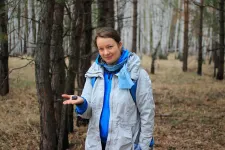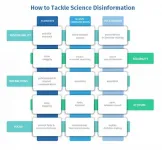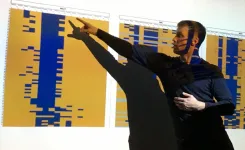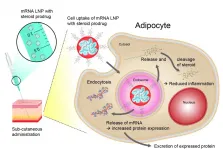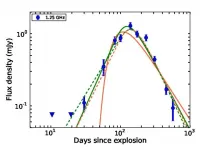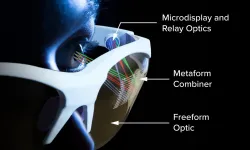Strong and flexible cofactors
Cube-shaped iron-sulfur clusters support multiple bond between iron and nitrogen
2021-05-03
(Press-News.org) In a number of biological processes, iron-sulfur clusters play a vital role, where they act as cofactors to enzymes. Research published in Angewandte Chemie now shows that cubic clusters can support unusual bonding states. This study shows that the cluster copes well with a multiple bond between iron and nitrogen--a structural motif that may be involved in biological nitrogen fixation.
Clusters made of iron and sulfur atoms are essential cofactors for a number of enzymes, especially in biological processes involving electron transfer. As an example, nitrogen-fixing bacteria use iron-sulfur clusters to convert nitrogen from the air into useful nitrogen compounds. To understand this important biological process, scientists dig deep into the bonding relationships possible between nitrogen and iron atoms in such clusters.
Daniel Suess and colleagues, from Massachusetts Institute of Technology in Cambridge, USA, have now investigated the cluster's capability to form unusual bonds between iron and nitrogen. A double bond, which is part of a chemical group called an imide, may play a role in nitrogen fixation.
To construct the imide, the team began by producing a cube-shaped iron-sulfur cluster. The eight corners of the cube are occupied by alternating iron and sulfur atoms; three of the iron atoms are protected by chemical species serving as ligands. These ligands do not bond directly to the atoms, and just shield them instead. The remaining unshielded iron atom of the cluster was bound to a replaceable chloride ligand. Careful selection of the reagents enabled the team to swap out the chloride ion and then, by oxidation with a nitrogen-containing reagent, the tricky double bond between the unique iron atom and the nitrogen atom--and thus the imide group--was formed.
The researchers expected that the iron-nitrogen double bond could strongly distort the cluster's structure. Instead, to their surprise, they observed only minor structural changes. The authors' spectroscopic studies explain this finding: the electron-rich imide pushes away electron density from the neighboring sulfur and iron atoms, and the totality of these minor effects is what allows the cluster to accommodate the imide bond. "These findings demonstrate a dynamic interplay between iron-nitrogen, iron-sulfur, and iron-iron bonding," state the authors.
The new imido-bound cluster was able to cleave weak carbon-hydrogen bonds from organic reagents. The authors intend to use these studies as a starting point for further investigation of the reactivity of imide-bound iron-sulfur clusters. "This highlights the promise of exploiting the synergy between the structural robustness and electronic flexibility of these fundamental cofactors," Suess says.
INFORMATION:
About the Author
Dr. Daniel Suess is the Class of 1948 Career Development Assistant Professor at the Department of Chemistry of the Massachusetts Institute of Technology, Cambridge, USA. The Suess research team tackles problems at the interface of inorganic and biological chemistry, focusing primarily on the physical properties, chemical reactivity, and biological function of metal--chalcogenide clusters.
http://suessgroup.mit.edu/
ELSE PRESS RELEASES FROM THIS DATE:
2021-05-03
An international team of scientists from 20 countries identified 47 problems that hinder the successful prevention and elimination of the consequences of the tsunami. Based on the carried out analysis, the world's leading experts on natural hazards have outlined directions for further scientific research. The research group's review is published in a special issue of the "Frontiers in Earth Science".
The main problems identified in the review are related to the large gaps and uncertainties in knowledge about tsunami, the lack of well-documented observations, and imperfect methods of processing available information. One of the reasons is the lack of coordination of the efforts of those countries for which the study and prediction of tsunamis, forecasting the corresponding risks, and preparation ...
2021-05-03
Berlin, 3 May - In a new report, ALLEA, the European Federation of Academies of Sciences and Humanities, examines the potential of technical and policy measures to tackle science disinformation and calls for improved European exchange and coordination in this field.
While disinformation strategies are intoxicating public discourses in many fields, science disinformation is particularly dangerous to democratic governance and society at large. As highlighted by the ongoing pandemic, an undermining of trust in science poses a fundamental threat to political and individual decisions based on evidence and scientific knowledge.
Over ...
2021-05-03
Impaired bone health is among the most significant long-term consequences of hematopoietic stem cell transplantation (HSCT), a common therapy for patients with malignant and non-malignant haematological diseases.
To address this serious problem, the International Osteoporosis Foundation (IOF) expert Working Group on Cancer and Bone Disease has published a new Executive Summary of its authoritative state-of-the-art review. The review outlined the major factors affecting bone health in HSCT patients, and provided expert guidance for the monitoring, evaluation and treatment of bone loss in these patients. ...
2021-05-03
Globally, tuberculosis is the most common bacterial infectious disease leading to death. The pathogen causing tuberculosis, Mycobacterium tuberculosis, has a number of peculiarities. One is that it is growing very slowly. While other typical pathogens, such as pneumococcal and pseudomonads, can already be identified by their growth in the microbiological laboratory in the first 72 hours, several weeks usually pass before tuberculosis bacteria grow in the lab. Thus it often takes one to two months before the efficacy of individual medicines can be tested.
However, these efficacy tests are essential for the effective treatment of multidrug-resistant tuberculosis (MDR-TB), which is becoming increasingly common. In these cases, the pathogen has become ...
2021-05-03
If not before, then certainly since the first messenger RNA (mRNA) vaccines to combat the SARS CoV2 virus were approved in Germany, mRNA has become a recognized term even outside scientific circles. What is less well known is that mRNA can be used to produce much more than just vaccines. Around 50 different procedures for the treatment of diseases including cancer are already being studied in clinical trials. Scientists from the pharmaceutical company AstraZeneca, with the support of neutron researchers from Forschungszentrum Jülich, have now discovered how the subcutaneous administration of mRNA can be improved. The goal is for chronically ill ...
2021-05-03
Scientists from the National Centre for radio Astrophysics of the Tata Institute of Fundamental Research (NCRA-TIFR) Pune used the upgraded Giant Metrewave Radio Telescope (uGMRT) to determine that AT 2018 cow, the first of a newly discovered class of cosmic explosions, has an extremely patchy environment. Sources like AT 2018cow release an enormous amount of energy, nonetheless fade extremely rapidly. This along with their extremely blue color has led to them being called FBOTs for Fast Blue Optical Transient. This is the first observational evidence of inhomogeneous emission from an FBOT. The origins of FBOTs are still under debate, but proposed models include explosion of a massive star, collision of an accreting neutron star and ...
2021-05-03
"Image" is everything in the $20 billion market for AR/VR glasses. Consumers are looking for glasses that are compact and easy to wear, delivering high-quality imagery with socially acceptable optics that don't look like "bug eyes."
University of Rochester researchers at the Institute of Optics have come up with a novel technology to deliver those attributes with maximum effect. In a paper in Science Advances, they describe imprinting freeform optics with a nanophotonic optical element called "a metasurface."
The metasurface is a veritable forest of tiny, silver, nanoscale structures on a thin metallic film that conforms, in this advance, to the freeform shape of ...
2021-05-03
According to Michael Twidale, professor in the School of Information Sciences at the University of Illinois Urbana-Champaign, bad usability can be an irritation for everyone but "especially awful" for the underprivileged. In "Everyone Everywhere: A Distributed and Embedded Paradigm for Usability," which was recently published in the Journal of the Association for Information Science and Technology (JASIST), Twidale and coauthors David M. Nichols (University of Waikato, New Zealand) and Christopher P. Lueg (Bern University of Applied Sciences, Switzerland) present a new paradigm to address the persistence of difficulties that people have ...
2021-05-03
(New York, NY) - May 3, 2021 - In advance of a wildfire season projected to be among the worst, the American Thoracic Society has released a report that calls for a unified federal response to wildfires that includes investment in research on smoke exposure and forecasting, health impacts of smoke, evaluation of interventions, and a clear and coordinated communication strategy to protect public health.
The report, Respiratory Impacts of Wildland Fire Smoke: Future Challenges and Policy Opportunities, was published online ahead of print in the Annals of the American Thoracic Society on May 3, 2021.
The report comes at a time when the U.S. is experiencing an increasing frequency of very large destructive wildfires, due to years ...
2021-05-03
Over 400 common disinfectants currently in use could be made safer for people and the environment and could better fight the COVID-19 virus with the simple application of UVC light, a new study from the University of Waterloo shows.
Benzalkonium chloride (BAK) is the most common active ingredient in many disinfectants regularly used in hospitals, households, and food processing plants to protect against a wide range of viruses and bacteria - including all strains of SARS-CoV-2, the coronavirus that causes COVID-19 - but its toxicity means that it can't be used in high concentrations. It also means that products containing BAK are harmful to humans ...
LAST 30 PRESS RELEASES:
[Press-News.org] Strong and flexible cofactors
Cube-shaped iron-sulfur clusters support multiple bond between iron and nitrogen
